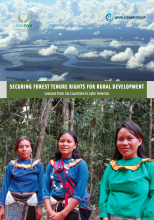/ library resources
Showing items 1 through 7 of 7.The purpose of this study is to assess
agriculture's competitiveness in Colombia. During the
past 12 years, Colombia's agricultural sector has
performed poorly, resulting in the continuation of extensive
Although many of the problems that Cali
is experiencing - social and human capital deterioration, a
declining economy, and institutional crisis - are a
reflection of Colombia's complicated socioeconomic
The book intends to trigger, and support
policy debate in Colombia. The first part distills four
thematic chapters, responsive to the country's current
realities, as well as to the five decades of development
As the use of Payments for Environmental Services (PES) approaches in developing countries has grown, concern has arisen over the ability of poorer households to participate.
Secure land tenure in rural landscapes is widely recognized as an essential foundation for achieving a range of economic development goals. However, forest areas in low and middle-income countries face particular challenges in strengthening the security of land and resource tenure.
Only 30 percent of land suitable for agriculture is utilized for crops (with significant regional variation). More than double the area suitable for pasture is used for livestock grazing, with negative environmental consequences.
This study on Latin America is based on a sample of eight countries, comprising the big four economies of Argentina, Brazil, Chile, and Mexico; Colombia and Ecuador, two of the poorest South American tropical countries; the Dominican Republic, the largest Caribbean economy; and Nicaragua, the poo
Land Library Search
Through our robust search engine, you can search for any item of the over 73,000 highly curated resources in the Land Library.
If you would like to find an overview of what is possible, feel free to peruse the Search Guide.




